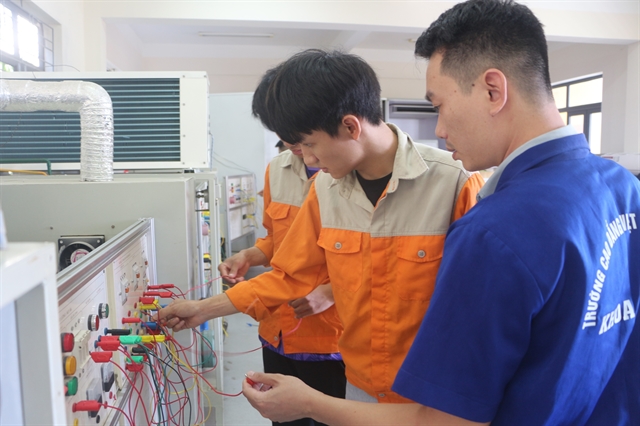 Society
Society

 |
| A practice session of electrical students at Việt Đức Nghệ An College. VNA/VNS Photo Bích Huệ |
HÀ NỘI The percentage of young people in Việt Nam undergoing vocational training makes up little more than 20 per cent of the entire youth population, according to the Ministry of Labour, Invalids and Social Affairs
The numbers suggest there is an urgent need to enhance young labour skills and quality, given the context of the fourth industrial revolution and current integration, Vietnam News Agency reported.
The production and workforce structures of the labour market of the future have undergone modifications due to the fourth industrial revolution.
The economy has undergone a rapid transition from one centred on resources and cheap labour, to one that is centred on information, with labour being replaced by machines, robots and artificial intelligence.
Numerous concerns regarding vocational education have been highlighted, since it is this sector which has the strongest and most direct ties to the labour market.
Vocational education, in contrast to university education, attempts to teach human resources from the ground up so they may work immediately and directly for a specific position in the labour market.
There are currently 1,886 vocational education facilities in Việt Nam, comprising 429 intermediate schools, 399 colleges and 1,058 vocational education centres.
Over 2.2 million enrolled in vocational education in 2023, comprising 530,000 college and intermediate level students, over 1.7 million elementary school students, along with a variety of other vocational training programmes.
The system of vocational education has been experiencing significant and timely innovation in line with the global trend of vocational education development.
The Ministry of Labour, Invalids and Social Affairs has been actively involved in the innovation and improvement of the quality of vocational education, fortifying ties with businesses, the labour market and social security, in order to improve vocational skills for workers in the context of the fourth industrial revolution.
The industry prioritises new sectors and occupations while focusing on breakthroughs in enhancing the quality of human resources, particularly high-quality human resources, and important and spearhead industries to meet labor market demands.
Besides opportunities, vocational education is also facing many new challenges in terms of management, school administration, programmes, textbooks, facilities, teacher capacity as well as new skills and the emergence of new occupations. That requires workers to be trained promptly to appropriately meet development needs.
According to the General Statistics Office, as of the first half of 2024, Việt Nam’s labour force (aged 15 and above) was 52.5 million people. Among them, 51.4 million people are employed, an increase of 195,700 people compared to the previous year.
Approximately 28 per cent of workers possess certifications for competent training.
In general, the number of employed workers tends to increase, but the labour market development remains unsustainable when the number of workers with informal jobs accounts for a large proportion.
According to the office, the unemployment rate for young people (those between the ages of 15 and 24) has increased to 8 per cent, or 0.49 percentage points.
The young unemployment rate is always high and more than three times greater than the working-age population's rate due to the youth’s higher demand for jobs.
Young people are often equipped with good knowledge and high qualifications, so they have more opportunities to choose the right job as they want rather than working in temporary, low-income jobs. The rate of workers not using their full potential was 4.3 per cent, down 0.1 percentage points.
Expanding vocational education
Numerous experts believe that vocational education needs strong innovation, to not only train workers, but also meet the requirements of integration and competition.
The General Department of Vocational Education has proposed diversifying the forms of vocational education and expanding it to the secondary level.
After completing secondary school, students are encouraged by the Government to enroll in vocational education.
Career orientation has received attention from numerous secondary schools when students are ready to graduate from the ninth grade and before they select a high school.
New majors and tuition discounts are offered by colleges and vocational training programmes to entice students.
The General Department of Vocational Education also focuses on improving training quality of vocational schools, some of which have partnered with companies to place graduates into positions.
Đồng Trung Chính, principal of Hà Nội College of Industrial Economics, said all majors offered by the school are dependent on enrollment requirements. Additionally, the institution has partnered with several companies to accept graduates.
Because only businesses can have the most correct orientation regarding technology, short-term and long-term requirements for the workforce, it is necessary to build industry skills councils with the participation of businesses to plan macro policies, forecast labour and employment, determine industry standards. VNS




